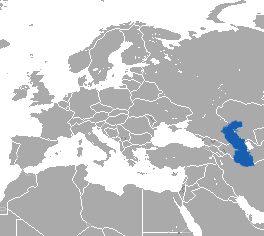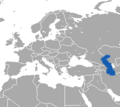Caspian seal facts for kids
Quick facts for kids Caspian seal |
|
|---|---|
 |
|
| A Caspian seal in Iran | |
| Conservation status | |
| Scientific classification | |
| Genus: |
Pusa
|
| Species: |
caspica
|
 |
|
| Caspian seal range | |
| Synonyms | |
|
|
|
The Caspian seal (Pusa caspica) is a small type of earless seal. It is special because it lives only in the Caspian Sea. This sea has slightly salty water. These seals live along the shores, on rocky islands, and on floating ice.
In winter, they stay in the northern Caspian Sea. When the ice melts in summer, they move to river deltas like the Volga and Ural River. They also go to deeper, cooler parts of the southern Caspian Sea. Scientists think these seals came from the Arctic a long time ago. They got stuck in the Caspian Sea when old river connections disappeared.
Contents
About Caspian Seals
Caspian seals are not very big. Adult seals are about 126 to 129 centimeters (50-51 inches) long. Males are usually a bit bigger and heavier than females. An adult seal weighs around 86 kilograms (190 pounds).
The Caspian seal is related to the Baikal seal. Both seals likely came from the ringed seal. Ringed seals moved from larger oceans about two million years ago.
These seals are very good at living in different temperatures. The Caspian Sea can be very cold in winter, about -35°C (-31°F). In summer, it can be very hot, up to +40°C (104°F). Caspian seals can handle these big changes.
In early April, female seals and their pups start moving south. They look for fish to eat during this trip. Male seals stay in the north longer to finish shedding their old fur. In summer, seals rest in quiet spots.
What Caspian Seals Eat
Caspian seals mainly eat fish. Their diet changes with the seasons and what food is available. In the northern Caspian Sea, they eat small crustaceans and many types of fish. These include sprats, gobies, and roach.
Adult Caspian seals eat about 2 to 3 kilograms (4-7 pounds) of fish every day. That's almost a metric ton of fish each year!
In autumn and winter, they eat mostly sculpins, gobies, and crustaceans. They find these in the shallow northern parts of the sea. In summer, they eat herring, roach, carp, and smelt in the southern parts. When they are near river mouths, they eat freshwater fish. They also eat shrimp and crab.
How Caspian Seals Behave
Caspian seals are not deep divers. They usually dive about 50 meters (164 feet) for about one minute. But sometimes, they can dive deeper and stay underwater longer. After they find food, they rest on the surface of the water.
During mating season in summer and winter, Caspian seals live in large groups. At other times of the year, they prefer to be alone. In summer, they might make loud snorts or wave their flippers. This tells other seals to keep their distance.
Seal Families
Male and female Caspian seals usually stay with one partner. They do not fight much over mates. In late autumn, they travel to the northern Caspian Sea. The water there is shallow and frozen. Females give birth on ice sheets after being pregnant for 11 months.
Usually, about 40 to 70% of females get pregnant. But now, this number is very low, around 30%. In late January or early February, female seals give birth to one pup. These pups are born with white fur and weigh about 5 kilograms (11 pounds).
Mother seals often fast (don't eat) while nursing their pups. Pups drink milk for a few weeks. Their white fur falls off when they are about three to four weeks old. Male pups can have babies when they are six to seven years old. Female pups can have babies when they are five to seven years old. Young seals are not fully grown until they are 8 to 10 years old.
After breeding and shedding their fur, Caspian seals move back south. They go to the deeper, colder waters of the southern Caspian Sea for the summer.
Seal Health Problems
Sadly, many Caspian seals have died from a disease called canine distemper virus. This happened in 1997, 2000, and 2001. In April 2000, many seals died near the Ural River in Kazakhstan. More than 10,000 seals died along the coast.
Sick seals looked weak and had muscle spasms. They had discharge from their eyes and noses, and they sneezed. Scientists found that the canine distemper virus caused these deaths. This virus is similar to the one that affects dogs. The same virus infected seals across the Caspian Sea. This suggests the virus stayed in the seal population or came from land animals.
Some studies also found other infections in the sick seals. A mild winter before the 2000 die-off might have also played a role. The warmer weather could have made the ice melt faster in their breeding areas.
Dangers to Caspian Seals
A hundred years ago, there were about 1.5 million Caspian seals. By 2005, only about 104,000 were left. Their numbers keep dropping by 3-4% each year. This is mainly because of human activities. Seals get caught in fishing nets and lose their homes. Diseases and climate change also hurt them. By 2022, there were only about 70,000 seals left.
Pollution from industries in the area also harms the seals. High levels of zinc and iron were found in dead seals. These chemicals can weaken the seals' immune systems.
Sea eagles hunt young seals, causing many deaths. People also hunt these seals for food and trade. Icebreaker ships sometimes go through areas where seal pups live. This can destroy their homes.
New buildings and resorts are being planned in places like Kenderli Bay. This bay is important for seals when they travel. These new developments could disturb the seals and their homes. Experts have warned local leaders about protecting these areas.
In December 2022, many seals died again. Reports first said 700 seals died, but later it was changed to 2,500. The reason for this mass death is still unknown.
See also
- Tyuleniy Archipelago and Tyuleny Island, both named after the Caspian seals
- Ringed seal, Pusa hispida
- Baikal seal, Pusa sibirica
Images for kids




